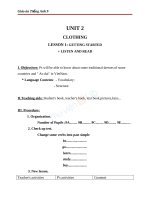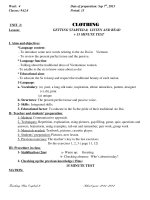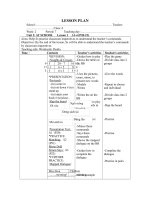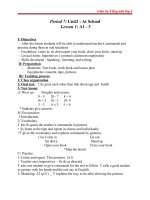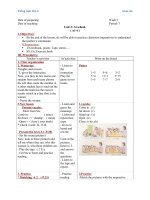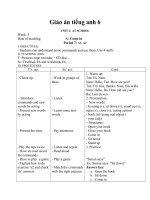Giáo án Tiếng Anh 9 Unit 2: Clothing
Bạn đang xem bản rút gọn của tài liệu. Xem và tải ngay bản đầy đủ của tài liệu tại đây (162.49 KB, 19 trang )
TIẾNG ANH 9 – GIÁO ÁN
UNIT 2 : Clothing
Lesson1: Getting started
Listen and read
I. Objectives : Students will know some more about ao dai, the traditional
dress of Vietnamese
women
II. Language contents :
1. Vocabulary : poet (n), long silk tunic (n), (to) slit (n / v),
inspiration (n), ethnic minority (n), pattern (n)
2. Structure :
- The present perfect tense ( review )
- The passive forms.
3. Skills : Listening, speaking, reading, writing
III. Techniques: gap filling, answer given
IV. Teaching aids : Textbook, pictures of ao dai
V. Procedure
CONTENTS
TEACHER’S AND STUDENTS’
ACTIVITIES
a. GETTINGSTARTED
Warm up
* Quiz :
- T. devide class into groups, ask them to look
at the clothes people are wearing in the picand take turn to decide where each person
comes from.
- T. suggest some questions and
- S. answer about the people in the picture.
* Suggested questions and answers :
?1. Picture a) : Where does she come from ?
– She comes from Japan.
?2. How do you know ?
– She is wearing a kimono.
-T. let students discuss the questions.
-T. introduce new words about the traditional
clothes of some countries.
* Note some new words :
- kimono : bộ áo dân tộc truyền thống của
Nhật Bản.
- kilt : váy xếp nếp bằng vải len kẻ oâ vuông
của người miền núi Scotland.
- sari : vải quán quanh thân người thay cho
quần áo của phụ nữ Aán Độ
- veil : mạng che mặt
- T. call S to answer
b.LISTEN AND READ
* Answers :
a. She comes from Japan.
* New words :
b. She comes from Viet Nam.
- poet (n) : Ex : Nguyen Du, To Huu,
c. He comes from Scotland.
Huy Can … are poets.
d. She comes from India.
- long silk tunic (n) : áo lụa dài và rộng
e. He comes from the USA.
- (to) slit (v / n) : (to make) a long thin
f. She comes from (Saudi) Arabia.
cut in something : xẻ / đường xẻ
-T. check and correc
- inspiration (n) : cảm hứng, hứng khôõi
- Set the scene : You are going to listen and to take inspiration from something :
read a text about the traditional dress of Viet lấy cảm hứng từ …
Nam, ao dai (T. use pictures of some different - ethnic minority (n) : Ex : Thai,
ao dai to introduce and introduce new words in Muong, Ede, H’ mong … are ethnic
the text.
minorities.
- Checking vocabulary : Rub out and b) answer these questions a) Complete
remember.
the sentences. Use the information from
-T. ask students to listen and do the exercise a) the passage.
- S. listen to the text twice, then read the * Answers :
sentences that have dificult intonation and new 1. … poems, novels and songs.
words or new phrases.
2. … long silk tunic with slits up the
- 5 students called to give the 5 answers.
sides worn over loose pants.
- T. correct
3. … to wear modern clothing at work.
- S. asked to read the main sentences to check 4. … lines of poetry on it.
their answers.
5. … symbols such as suns, stars, crosses
-T. let students read the text again (silent) . and tripes.
Then S work in pairs to ask and answer the
questions in exercise b)
-Af about 6 minutes S called to to practice in * Answers :
front of the class. Then 3 other students to 1. Traditionally, men and women used to
write the answers on the board.
wear the ao dai.
- T. check and correct. ( if necessary )
2. Because it is more convenient.
-T. make S note some grammar points in the 3. They have printed lines of poetry on it
text.
or have added symbols such as suns,
* Note :
stars, crosses, and stripes to the ao dai.
1. The present perfect tense :
S + have / has + V(p.p)
2. The passive forms :
S + be + V(p.p)
- Simple present : be am / is / are
- Simple past : be was / were
- Present perfect : be have / has been
- Simple future : be will / shall be
- Modal verbs : be modal verbs be
- Asks students to use their own words to tell
the group what they have known about the ao
dai.
* Homework :
- Asks students
- Write what they have spoken to their partners
and adding their opinion whether they like
wearing the ao dai or not.
- Learn their lesson.
- Prepare for the next period : Speak; Listen )
UNIT 2 : Clothing
Lesson2: Speak and Listen
I. Objectives : To ask and respond to questions on personal references.
II. Language contents :
1. Vocabulary : The words and phrases in exercise a)- page 14.
2. Structures :
3. Skills : speaking
III. Techniques: word square, answer given
IV. Teaching aids : Textbook, pictures
V. Procedures :
ACTIVITIES
a) Match the phrases to the pictures :
- Asks students to do the matching individually,
then compare with their partners to check.
CONTENTS
UNIT 2 : CLOTHING
Period 8. SPEAk
- Calls some students to tell the class about their
answers.
* Answers :
- Checks and corrects.
a. a colorful T – shirt
* Check the vocabulary : Kim’s game
b. a sleeveless sweater
- Asks students to remember the phrases in 30 c. a striped shirt
seconds. Then let their books closed.
d. a plain suit
- Divides the class into four groups. Students e. faded jeans
from each group take turn to go to the board f. a short – sleeved blouse
write as many words as they can. Group with g. baggy pants
the most words wins the game.
h. a plaid skirt
b) Interview members of another group.
i. blue shorts.
- Asks students to work in groups 8 or 10
students each to read and write to more * Two more questions :
questions for the last section of the survey about - What type of clothing do you wear on
students’ wearing.
Tet holiday ?
- Explains and guides students to pay attention - What would you wear to a party ?
to the phrases in exercise a) before they
interview.
- Calls some groups to interview again in front
of the class.
- Corrects students ‘ mistakes if necessary.
c) Report the results of the survey :
- Explains the requirement of the task.
- Lets students read the examples in the
textbook.
- Asks students to report the results of their
survey.
- Calls the leader of each group to present the
results of the survey in front of the class.
- Corrects students ‘ mistakes if necessary.
* The survey should begin as this :
- Three people said they liked their uniform.
- Two people said they usually wore colorful T- Listen
shirt on the weekend.
- Lan said she loved gaggy pants.
Pre-listening:
T." in this lesson, you will hear a public
announcement about a lost little girl. First you
nae the clothes in the pictures".
You will hear a public announcement
Ss. name the clothes:
about a lost little girl called Mary.
a) A: floral pants; B: blue shorts; C: polka dot Listen and check ( ) the letter of the
skirt
correct picture to show what Mary is
b) A: long-sleeved white blouse; B: short- wearing.
sleeved pink shirt; C: short-sleeved white shirt.
a) A: floral pants; B: blue shorts; C:
c) A:sandals; B: boots; C: shoes with flowers.
polka dot skirt
T. "Now you listen to the tape and check the b) A: long-sleeved white blouse; B:
letter of the correct picture you hear."
short-sleeved pink blouse; C: short-
While-listening:
sleeved white blouse.
Ss. listen and check the correct letter of the c) A:sandals; B: boots; C: shoes with
picture they hear.
flowers
Ss. compare what they hear with their partner’s The answers:
result
a) B: She is wearing blue short.
Post-listening:
b) A: She is wearing a long
T. gets Ss to give the answers
S. write on the board.
-sleeved blouse
c) C: she is wearing brown shoes
T. lets Ss listen sentence by sentence to check
the result
The tape transcript
Attention pleasse. Here is a special
announcement a little girl is reported
missing. She was last seen twenty
minutes ago near the main entrance to
the Car Fair. Her name is Mary and she
is three years old. She has short dark
hair. She is wearing shorts- blue shorts
and a long- sleeved white blouse. She
is wearing a pair of shoes- brown
shoes. She may be carrying a large doll
Homework :
If you see Mary, bring her to the
Asks students :
information Desk. Her father is waiting
- To write a short passage to describe clothes for her here. Thank you.
they like.
- Learn their lessons.
- Prepare for the next period : Read -Unit 2
UNIT 2 : Clothing
Lesson2: Read
I. Objectives : supply S information about history of jeans.
II. Language contents :
1. Vocabulary : made from, named for, embroidered jeans, painted
jeans….
2. Structures : Review the past simple tense
3. Skills : reading
III. Techniques: answer given, gap filling
IV. Teaching aids : Textbook, pictures
V. Procedures :
Activities
Warm – up answer given.
T. get S to look at some pictures that T shows
and ask What they are wearing.
S. answer:
PreT. show S the picture in page 17 and asks what
they are wearing.
S. answer: They are wearing jeans with….
T. do you want to know when jeans were made
from, what they were named after… we are
going to listen the text and then read it to know
more
Contents
UNIT 2 : CLOTHING
Period 10. READ
S. pick out some new words and T help S learn
them
T. have S read the text again and then fill in the
missing date and words in exercise a)
While-
a) Fill in the missing dates and words.
S. practice with their partners in 7’ t
Post-
a) In the 18th century: Workers liked
S.fill in the missing dates and words in the
to wear jean cloth because the
board after comparing with their partner’s
material made from cotton was
result
very strong and could hardly wear
T. remark and give feedback exercise a) a
out
T. then gets S to practice asking and answering
b) In the 1960s: A lot os university
with their partner exercise b) after reading the
and college students wore jeans.
text again..
c) In the 1970s: Jeans became
T. explain the questions
cheaper so many, many people
T. get S to give the answers (each pair)
began wearing jeans.
S. write on the board.
d) In the 1980s: Jeans became high
fashion clothiong.
e) In the 1990s: the sale fo jeans
stopped going up.
b) Answer. Then write the answers in
your exercise books.
T. remark and give feedback exercise b)
The answers:
d) The word “ jeans) comes from a
kind of material that was made in
Europe.
e) The
1960s’
fashions
were
embroidered jeans, painted jeans
and so on.
f) Because jeans became cheaper.
g) Jeans at last became high fashion in
Consolidation
the 1980s.
Discussion:
h) The sale of jeans stopped growing
Do you like wearing jeans? Why/ why not?
up because worldwide economic
Do you wear jeans in formal occasion?
situation got worse in the 1990s.
Homework :
T. emphasize main points of the lesson and ask
students :
- To write a short passage to describe clothes
they like.
- Learn their lessons.
- Prepare for the next period : Write -Unit 2
UNIT 2 : Clothing
Lesson2: Write
I. Objectives : Helping Ss how to present one side of an arguments, especially
about wearing
uniform in school.
II. Language contents :
1. Vocabulary : my opinion is…; I think…; firstly; secondly…;
therefore; in clusion,
2. Structures : Review the simple present tense
3. Skills : writing
III. Techniques: report
IV. Teaching aids : Textbook, sub board
V. Procedures :
ACTIVITIES
Warm – up answer given.
T. gets Ss to look at some pictures that T
shows and asks What they are wearing.
Ss. answer:
T. asks Ss
1. Do you like wearing jeans? Why? Why
not?
2. Should you wear jeans at school?
Why? Why not?
Pre-
CONTENTS
UNIT 2 : CLOTHING
Period 11. WRITE
T.introduces the new lesson:" you have argued
with each other to protect your idea and refute
others. In writing, there is an argumentative writing
which presents one’s ideas, opinion and make them
persuasive to readers. At the same time, this kind
of writing has to sucessfully protect it’ opinions and
refute the opposite ones. First you should
understand
clearly
the
structure
of
an
arguementative writing. Is has three part as in the
This is how to present one side of an
text book."
argument.
Mở bài
Cấu trúc
Ngôn ngữ
Cho độc giả Tôi nghĩ…
biết quan điểm Theo
của
quan
Organization Language
Introduction Lets
the My opinion
gngười điểm của tô…
reader know is…
viết( đồng ý
hoặc
Thân
đồng ý)
Trình
the
không
Series
bày Trước hết
writer’s I think…
point of view
of Presents
arguments
Firstly,…
arguments in Secondly,…
bài( các những ý tranh Thứ hai là
a logical way, Finally,…
ý
give example
tranh luận theo một ….
luận.).
cách
logic
where
nhất, cung cấp
dẫn chứng khi
Kết luận
Conclusion
possible
Sums up the Therefore,…
argument
cần thiết
Tóm tắt những Tóm lại
In
conclusion
ý đã trinh bày …
và khẳng định
a)Read the topic and Outline A. Then read
quan điểm của
the passage
người viết
T. has Ss read the outline a)
Ss then fill in the missing date and words in
exercise a) and then read the passage
Ss. read it aloud.
T:" you have read an argument that supports
b)
the idea that secondary students should wear
uniform. Now use the outline B as the
guidelines write a paregraph that sopports
that secondary students should wear casual
clothes."
WhileSs. write a paragraph of 100-150 words,
compare it with their partner’s one
• Bear their school’s name
• Feel equal
• Practical
b)Now write a paragraph of 100-150
words. But this time you support the
argument that secondary school students
should wear casual clothes. Outline B
may help you.
Secondary school students should wear
casual clothes.
Wearing casual clothes:
Post-
• Make students feel comfortable.
Ss. read the text before class
• Give students freedom of choice
Ss. write on the board
T. remarks and gives feedback exercise b)
(size, color, and fashion, etc.).
• Make
students
feel
more
self-
confident when they are in their
Consolidation
Ss. asked report their writing
favorite clothes.
• Make school more colorful and lively
• Feel comfortable
• Freedom of choice
* Suggested writing
I think it’s necessary for secondary school
students should wear casual clothes.
Firstly.wearing casual clothes make students
feel comfortable.
Secondly, wearing
Homework :
casual clothes give
students freedom of choice (size, color, and
T. emphasizes main points of the lesson and fashion, etc.).
ask students :
Thirdly, wearing
casual clothes make
- To write a paragraph. The topic is” why students feel more self-confident when they
shouldn’t secondary school students wear are in their favorite clothes.
casual clothes?”
Finally, wearing casual clothes make school
- Learn their lessons.
more colorful and lively.
- Prepare for the next period : Language In conclusion. Students in secondary should
focus -Unit 2
wear casual clothes.
UNIT 2 : Clothing
Lesson6: Language focus
I. Objectives : Review the present perfect, the passive
II. Language contents :
1. Vocabulary : review
2. Structures : Review
3. Skills : reading
III. Techniques: answer given
IV. Teaching aids : Textbook, pictures
V. Procedures :
ACTIVITIES
CONTENTS
T. divides class into groups.and do this
UNIT 2 : CLOTHING
Warm – up
exercise.
Period 12. LANGUAGE FOCUS
Since
for
List: last month, a long time, two hours,
September, 2 o’clock , several days, 2005,
yesterday, Sunday, ten years, one minute,
T. remarks and gets Ss to give the usage of
since and for
Activity 1
T. asks Ss to work with a partner. Read the
1) Work with a partner. Read the
dialogue
b)
- Lien, come here and see my photo
album.
dialogue
- Oh, so beautiful. Who is this boy?
Ss. practice in front of class.(in pairs)
- It’s Quang, my brother’s friend.
T. "now use the information in the table to
- How long have you known him?
make similar dialogues."
a) Lan- old
friend
b) Quangbrother’s friend
c) Hoa- new
- I’ve known him for seven six
Six years
2003
Seven
January
months
Three weeks
months.
- Have you seen him recently?
- No, I haven’t seen him since
January
Monday
friend
S. do (in pairs)
S. asked to practice in front the class.
Activity 2
T. " Work with a partner. Imagine you and
your partner are visiting Ho Chi Minh City.
Ask and answer questions about the things you
have done. Use the present perfect tense of the
2) Work with a partner. Imagine you
and your partner are visiting Ho Chi
Minh City. Ask and answer questions
about the things you have done. Use
the present perfect tense of the verb in
the box.
verb in the box."
do visit see go eat
Example:Have you seen Giac Lam pagoda yet?
- Yes, I’ve already seen it.
- Have you eaten Vietnamese food yet?
- No, I haven’t
Ss. do the same and then practice in front of
class.( in pairs)
Activity 3
- Have
you
seen
Reunification
Palace yet?
- Yes, I’ve already seen it.
- Have you eaten vegetarian food
yet?
T. "Work with a partner. Ask and answer
questios about each items in the box"
Comic
computer
supermarket
Volleyball
Elephant
Example:
- No, I haven’t
3) Work with a partner. Ask and
answer questios about each items in
the box
Singapore
movies
Hue
durian
- Have you ever read a comic?
- Yes, I have.
- When did you last read one?
- This morning.
- Have you ever been to Singapore?
- Have you ever seen an elephant?
- Yes, I have.
- When did you last see one?
- Last week.
- Have you ever eaten durian?
- No, I haven’t.
- No, I haven’t.
Ss. do the same, then practice in front of class.
Activity 4
T." Read the first sentence and then complete
the second sentence with the same meaning.
Use the passive form."
Example:
They sell jeans all over the
world.
Jeans are sold all over the world.
T." before do the rest. You give me some
formations of passive form."
The simple present and the simple past
To be + V-ed/ V3
Ss. do them with their partner and then write on
4) Read the first sentence and then
complete the second sentence with the
same meaning. Use the passive form.
a. Jeans cloth was made completely
from cotton in the 18th century.
b. Rice
is
gromn
in
tropical
countries.
c. Five million bottles of champagne
will be produced in France next
the board.
year.
T. corrects and gives the feedback
Activity 5
d. A new style of jeans has just been
introduced in the USA.
T. "change the sentences from the active into
the passive."
e. Two department stores have been
built this years.
Example:
You must do this exercise
carefully.
This exercise must be done carefully
T. gives this structure
Ss. answer
Modal verbs+ Ved/ V3
S. do them with their partner and then write on
the board.
T. corrects and gives the feedback
Homework :
T. emphasizes main points of the lesson and
asks students to:
- Review all their lessons.
- Prepare for the next period : Test 45’
5) change the sentences from the active
into the passive.
a. The problem can be solved.
b. Experiments on animals should be
stopped.
c. Life might be found on another
planet.
d. All the schools in the city have to
be improved.
e. A new bridge is going to be built
in the area.
